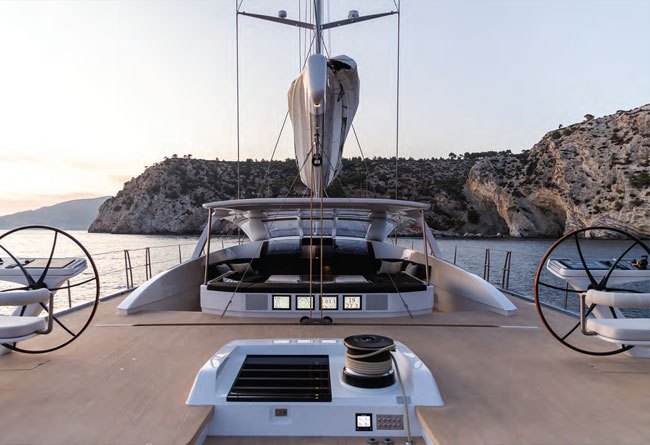

Telescopic keel, retractable propulsion, high-pressure hydraulics but just 88-tonne displacement for 112-feet of luxury performance... not only that, but Baltic Yachts’ Liara may well be the quietest running superyacht launched to date
Those of us lucky enough to cross an ocean or race offshore for any length of time will have an innate sense of appreciation and wonder at the beauty and power of the sea – it’s this very primal urge within us that binds us all together as sailors. And yet, as we know, some of the most important features of the sea and its ecosystems are under threat from human interference – most likely for the first time in the planet’s history. Consequences now include measurable effects and influence on not just our aesthetic values as sailors but also the lives and well-being of those who depend on being on and around the sea.
Evolution and not revolution sounds less interesting perhaps than foil- driven hyperdrive super-eco, but when the level of refinement and development into what is a challenging genre of yacht reaches new heights, then it becomes very interesting indeed.
The brief for Baltic Yachts, as always, appears simple but it is the detail and execution that makes Liara a defining yacht. Following in the design footsteps of notable yachts such as Ribelle and Missy, the proven formula of exceptional performance combined with sweeping good looks delivered by the offices of Malcolm McKeon Yacht Design (MMYD) combined to take this genre of mid-sized performance superyachts to another level.
Liara started life on the drawing board at 110ft but it soon became apparent that to include the Baltic Yachts-developed RPS (retractable propulsion system as seen on Baltic 130 My Song) and everything else the client wanted, she would need to be lengthened to 112ft.
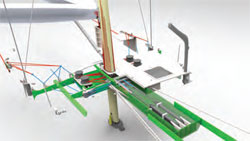
The boat needed to be competitive under superyacht rules, but also enable the owner to travel worldwide with all the luxuries of home. The compromise between cruising comfort and weight savings is always a tricky one, but this is a compromise Baltic Yachts are unmatched at delivering, to the extent that it never feels like a compromise at all, rather the melding of two objectives into an impeccable package.
Lighter, stiffer, faster – together. The mantra, indeed credo of Baltic Yachts was the perfect fit for a yacht that was intended to refine a proven and successful formula, yet also to take it to the next level.
With a keen eye towards performance, Baltic Yachts was the obvious choice for the experienced client to build his vision for his third Liara. After two previous yachts of increasing size, which have cruised the world and taken part in the most prestigious regattas, there was a clear sense of identity within the project team – which was led by John Walker the co-skipper and Sebastian Allebrodt of A2B management – of what the yacht was intending to achieve.
Ensuring the yacht was nimble enough to outperform the competition was crucial and John Walker and the team at Baltic developed some innovative systems to keep Liara ahead of the game, specifically the genoa sheeting system which is ‘classic Baltic’. In other words, it’s complicated in concept but simple in execution. Baltic prides itself in developing smart solutions for client ideas and the genoa sheeting is just that.
Fingertip sail trimming from the cockpit with a triple-headed sailplan to manage created some complexities for a short-handed crew. For optimum sailing performance the ability to trim headsails in three dimensions – athwartships, fore and aft and vertically at the clew – is critical. Previously this would have been managed by a series of complicated barber-haulers, inhaulers and tackles requiring fiddly hardware and considerable manpower and, fatally, aesthetic compromise. Under the foredeck of the Baltic 112 are four Harken hydraulic rams lying fore and aft on the centreline. One is used to operate the backstay deflector while the other three control a three-part bridle attached to a central ring through which the headsail sheet is led. Instead of having to tweak separate haulers and tackles to alter the trim of the sail, which may involve a crewman going forward to make the adjustment, everything can be done from aft at the touch of a button.
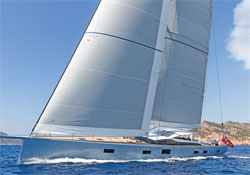
Above and below: three head-sails are set on separate furlers and sheeted to roughly 100 per cent of foretriangle. All three sets of sheets are precisely controlled by a three-part bridle running through a central ring to give precise, three-dimen- sional control of headsail sheeting angles from the helm, at the touch of a button. Itʼs a novel, lightweight solution that delivers optimum performance while avoid- ing the need for tweakers and inhaulers
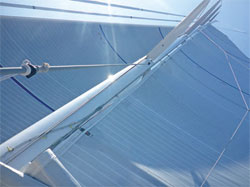
Co-skipper John Walker says: ‘Our aim was to have full control from the back of the boat, eliminating the need for tweakers and inhaulers. There are many ways to trim a sheet and you could do this with athwartships tracks, but I think we have a lightweight option that ticks all the boxes and looks good.’
Working in conjunction with this is a 350bar hydraulic system providing higher pressure to serve the many hydraulic functions on the yacht. Apart from the trimming system, they include three furlers, boom vang, mainsail cunningham, numerous mast winches, primary winches, secondaries, the anchor windlass, transom door, the RPS and keel lifting control. Until now most hydraulic systems have worked at 250bar. Ward Proctor of the Finland-based company Marine and Hydraulic says 350bar not only provides greater hydraulic capacity when demand is high – in a full-on gybe, for instance – but also requires smaller diameter high pressure stainless steel piping, plus smaller pumps and motors. ‘This all adds up to important weight and space saving,’ says Proctor. But will the system provide the hydraulic flow required in heavy demand manoeuvres on the racecourse? Walker says: ‘Time will tell! One thing I do know is the boys always want more “juice”! We are confident we’ll have the “grunt” we need and we’ve made some substantial weight savings too. I predict that this will be the new norm,’ he added. The bridle can be used on one of three headsails set on separate furlers, each of which sheets to roughly 100 per cent of the foretriangle. The system employs what is known as an absolute position indicator, which shows the trimmer the precise position of the pistons in the hydraulic cylinders at any given time.
Baltic Yachts’ in-house project manager Tommy Johansson says through strict adherence to weight schedules and the dedication of the team on the shop floor, ways have been found to further reduce weight. Liara’s final light ship displacement was measured at 88 tons.
Using CFD studies, MMYD was also able to confirm a considerable increase in performance provided by the yacht’s Retractable Propulsion System (RPS), especially in light to medium airs. ‘It was clear that the yacht would accelerate and power up much more quickly than expected with her propeller retracted,’ McKeon says.
A major engineering challenge for Baltic Yachts and the project team was posed by the juxtaposition of the hull aperture for the RPS and the telescopic keel. ‘It took us eight months to plan and engineer this, but we remained on schedule,’ Johansson says.
The yacht’s original machinery configuration was for a single engine and twin generators, but it was decided to fit a 60kW alternator off one of the main engine PTOs so that one of the conventional generators could be discarded, saving space and weight. The main engine is offset and drives the RPS via a 90°degree bevel gearbox. With a large lithium ion battery bank Liara can run in “silent” mode for up to eight hours with all “hotel” services running.
MMYD worked carefully on the shape and positioning of hull appendages to reduce wetted surface and drag. Work was also done to streamline the “steps” created by the telescopic keel fin to make the section more hydro- dynamically efficient. Through-hull fittings were reduced to a minimum to further reduce drag and for the same reason it was decided to opt for a single rudder, which also reduced weight.
 ‘The other great advantage of a telescopic keel is that, unlike a conventional lifting keel, it doesn’t encroach into the accommodation so when we were working with Adam Lay on the interior we had an immediate advantage in the deck saloon,” McKeon says. The solid removeable bimini is a significant feature of Liara. Elegantly sculpted and blending seamlessly with the profile of the yacht, it is easily removeable for racing but when cruising it provides protection from the elements and creates an extended living space for the owner.
‘The other great advantage of a telescopic keel is that, unlike a conventional lifting keel, it doesn’t encroach into the accommodation so when we were working with Adam Lay on the interior we had an immediate advantage in the deck saloon,” McKeon says. The solid removeable bimini is a significant feature of Liara. Elegantly sculpted and blending seamlessly with the profile of the yacht, it is easily removeable for racing but when cruising it provides protection from the elements and creates an extended living space for the owner.
With her powerful sailplan, the RPS drive which also rotates to act as a stern thruster, telescopic keel, high pressure hydraulics system for faster line speeds and high voltage electrical specification, Liara displays the latest thinking for a multi-role superyacht.
An added benefit of both the hydraulic and electrical systems is that they require considerably smaller diameter pipework and lighter electrical cabling which saves weight and space. The weight saving programme is supported by titanium being used in everything from stanchions and deck fittings to the hydraulic oil reservoir.
Jeremy Elliott who heads up North Design Services reflects: ‘One particularly pleasing result was the development of a headsail sheeting system that enables a full range of jib trims to be achieved around an expansive glazed area with minimal loaded lines above deck.
‘The 3Di A0 reacher, incorporating the HELIX Top Down Luff Cord, takes best advantage of load sharing luff projection together with the cast iron guarantee of Top Down Furling – racing or cruising, day or night.’
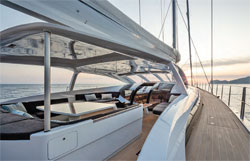 Above and below: despite her rather impressive performance credentials and a great emphasis on saving weight, Liara is still a sumptuously comfortable and luxurious cruising yacht with genuine go- anywhere voyaging capability. And what the pictures canʼt show is that despite the profusion of cutting-edge technology onboard, Liara is virtually silent under way even with all systems running. An enormous amount of effort and innovation has gone into engineering this to be the quietest running superyacht ever built
Above and below: despite her rather impressive performance credentials and a great emphasis on saving weight, Liara is still a sumptuously comfortable and luxurious cruising yacht with genuine go- anywhere voyaging capability. And what the pictures canʼt show is that despite the profusion of cutting-edge technology onboard, Liara is virtually silent under way even with all systems running. An enormous amount of effort and innovation has gone into engineering this to be the quietest running superyacht ever built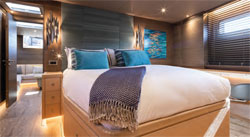
As an experienced yachtsman with a keen interest in engineering, the owner used the knowledge gained from his previous yachts to make Liara easy to handle by the core crew so that she could be quickly prepared for sailing. ‘By focusing on systems usability, these and other details make handling Liara’s running rigging and sail inventory much easier and faster so we can be sailing from anchor up in the shortest period of time,’ explains co-skipper Walker.
Both of Liara’s co-skippers, John Walker and Tom Haycock, who work on a rotational basis, have considerable experience in the J Class fleet and a lot of detailed deck design and ergonomics from that sphere of yachting has been used to help make Liara as easy as possible to sail.
Four hydraulic rams positioned under the foredeck provide touch button control of three-dimensional headsail sheeting bridles and rig deflectors, which enable the shape of the Southern Spars mast to be controlled. A “winch farm” by way of the mast partners, together with mast exit sheaves and rope tail compartments below deck level, can be hidden by sliding hatches once the yacht has been prepared for sea.
Further forward, asymmetric spinnakers and code sails each have dedicated bins so that they can be accessed and stowed quickly and easily. Right aft, Liara’s primary winches have been positioned abaft the steering positions enabling easy “cross-winching” – taking the headsail sheet to weather for trimming and other manoeuvres – and keeping the guest area completely free of running rigging.
In conclusion, after the thousands of hours of refinement and development Liara has proven herself to be as swift as expected, but especially impressive is the extraordinary sense of well-being onboard. She is virtually silent, a key mandate of the owner and an area in which Baltic Yachts truly stands alone.
Baltic Yachts has, over the past decade, invested heavily in sound insulation aboard composite yachts and is consequentially ahead of the competition in this area. Careful studies have been undertaken on how to optimise the use of the sound deadening material in the correct places. Already in the design phase Baltic ensures that all “noisy” equipment is positioned in the engine room (opposed to having it scattered all around the boat), which already is well insulated. All pieces of equipment (like pumps for example) are carefully selected based on their weight and noise output. It’s the Baltic approach to all projects, a team effort that starts with the engineers and continues through production and every Baltic team member on the shop floor. In another step ahead of the competition Baltic Yachts has also put a great deal of focus on the installation of piping, ensuring that pipework is not connected to the structure and that even the cabins are floating.
Baltic Yachts has again proved that a composite yacht can be silent.
Click here for more information on Baltic Yachts »
We invite you to read on and find out for yourself why Seahorse is the most highly-rated source in the world for anyone who is serious about their racing.
To read on simply SIGN up NOW
Take advantage of our very best subscription offer or order a single copy of this issue of Seahorse.
Online at:
www.seahorse.co.uk/shop and use the code TECH20
Or for iPad simply download the Seahorse App at the iTunes store


